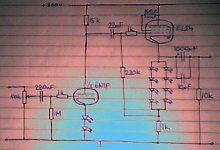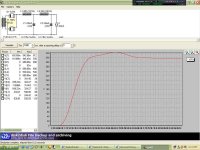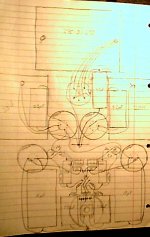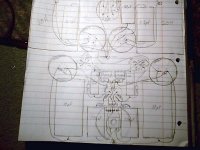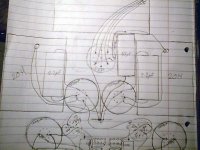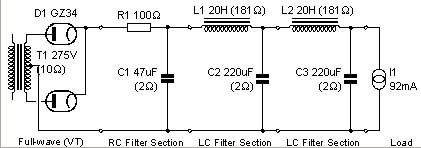Might be. I looked at Vishay's data sheet and from eyeballing the If vs Vf graph, it looks like the impedance is around 4 ohms or so at 50 ma. And the price is sure right.
Actually, in your application, the impedance is not really an issue, so these would certainly be worth giving a spin.
Actually, in your application, the impedance is not really an issue, so these would certainly be worth giving a spin.
I saw that graph too, thought it was fairly reasonable up to 100mA. Shame you'd need so many to bias a big output stage though  I was thinking maybe it can handle so much current partly because of the lower drop, and partly because it radiates infra-red?
I was thinking maybe it can handle so much current partly because of the lower drop, and partly because it radiates infra-red?
I was thinking of using them on a plain common cathod 6n1p input stage for this amp, biasing with one red and one IR led, giving around 3V bias. With a 15k load resistor the operating point sits at about 6mA so unfortunately that 100mA capability wouldn't be put to much use.
Steve
I was thinking of using them on a plain common cathod 6n1p input stage for this amp, biasing with one red and one IR led, giving around 3V bias. With a 15k load resistor the operating point sits at about 6mA so unfortunately that 100mA capability wouldn't be put to much use.
Steve
Hello again! More questions unfortunately...
Been playing with this in PSU designer, as it's shown here it says the transformer is 380V RMS, I think this means I need a 190-0-190 transformer but I'm not certain. Once it settles down ripple comes out at 0.16mV which I guess is fine, I hope.
Cheers,
Steve
Been playing with this in PSU designer, as it's shown here it says the transformer is 380V RMS, I think this means I need a 190-0-190 transformer but I'm not certain. Once it settles down ripple comes out at 0.16mV which I guess is fine, I hope.
Cheers,
Steve
Attachments
Hello, This is the layout I've come up with now. I wish I had a better camera, but hopefully the general idea should be clearish. It all just about fits onto a piece of A4 which I'm happy with. Is the case of a normal electrolytic tied to the -ve or +ve terminal? I think the JJ's are completely insulated, but I don't think the ones I intend to use as output are, and this could be a danger if it's the +ve that's connected to it as they will be outside the case (probably).
Cheers,
Steve
Cheers,
Steve
Attachments
And this is the power supply I think I'll go with. According to the simulation the peak current is ecceeded for about a third of a second with inrush current (hits a max of around 1.3A peak, but settles down to about 400mA peak), but I guess that this assumes the rectifier is preheated and ready to go, and won't start working gradually, so I think this should be ok. I'm tempted to have a go at a regulated B+ supply (the supply in my mini zen headphone amp is LM317 regulated, low voltage and easy to make and I'm happy with the sound of that) but I think I'll go with this for now. Ripple simulates at 4uV which ought to be ok. I've left plenty of room at the back of the case (on my piece of paper anyway) for a mains filter, some DC heater supplies and possibly a regulated B+ circuit in the future.
Thanks,
Steve.....eagerly awaiting student loan
Thanks,
Steve.....eagerly awaiting student loan
Attachments
Yes.....the headphone impedance market is about as non standard as 2nd hand cars are......from 20 Ohms til several Kohms.
I don't have any detail on Grados, but for Beyer,Sennheiser they all vary from model to model...... if you are going to use these with cathode follower o/p then one has to pay attention to the loading Z for min thd as this method doesn't have symmetrical drive.; implying a low Z load will clip the signal assymetrically.
Canford Audio has a pretty fair range of headphones with details; www.canford.co.uk
I use a sim circuit to the one you provided except I use ECC88 at 17mA into cap/parafeed step down tranny 3:1...for my main amp. The matching is better. The preamp is capable of 3V o/p at 0.01% THD @ 600 ohm output. I don't use phones oin this o/p simply because it would create distortion.
Although your subject is phones, I can recommend balanced o/ps for main amp use.
For running headphones with a lower Z ratio tranny say 8 ohms the ratio would be too high then the o/p level is way too low, and to bang it up to a couple of volts would push the cath follower stage into excessive distortion. (then one really use a SE power o/p stage and finito..)
Instead for better performance I use a LM1875 for phones to ignore user-specified phones. With the ultra low o/p Z the op amp isn't fussy what load it sees...Obviously the cathode follower running into Beyers DT109 with 400 ohms would be alot happier than 8 ohms with the DT100. You'll get sound alright but the drive will clip in the "tube off" condition. I'm not trying to pry you away from cathode followers for such apps but to see their limitations.
Beware of the old adage
<<It might sound worse than what you originally went out to acheive >> especially on the THD side.
For near-direct coupling in cathode follower use hi-impedance headphones for best results.
There seems to be an awful number of circuits using the "follower" electroytic cap as the cathode coupler.......not for me..., a startup mute is imperative incase you pull the wrong plug out of the wall and quickly re-insert it.......the plop isn't on for ones lug'oles nor pricy phones.
Only my opin.
rich
I don't have any detail on Grados, but for Beyer,Sennheiser they all vary from model to model...... if you are going to use these with cathode follower o/p then one has to pay attention to the loading Z for min thd as this method doesn't have symmetrical drive.; implying a low Z load will clip the signal assymetrically.
Canford Audio has a pretty fair range of headphones with details; www.canford.co.uk
I use a sim circuit to the one you provided except I use ECC88 at 17mA into cap/parafeed step down tranny 3:1...for my main amp. The matching is better. The preamp is capable of 3V o/p at 0.01% THD @ 600 ohm output. I don't use phones oin this o/p simply because it would create distortion.
Although your subject is phones, I can recommend balanced o/ps for main amp use.
For running headphones with a lower Z ratio tranny say 8 ohms the ratio would be too high then the o/p level is way too low, and to bang it up to a couple of volts would push the cath follower stage into excessive distortion. (then one really use a SE power o/p stage and finito..)
Instead for better performance I use a LM1875 for phones to ignore user-specified phones. With the ultra low o/p Z the op amp isn't fussy what load it sees...Obviously the cathode follower running into Beyers DT109 with 400 ohms would be alot happier than 8 ohms with the DT100. You'll get sound alright but the drive will clip in the "tube off" condition. I'm not trying to pry you away from cathode followers for such apps but to see their limitations.
Beware of the old adage
<<It might sound worse than what you originally went out to acheive >> especially on the THD side.
For near-direct coupling in cathode follower use hi-impedance headphones for best results.
There seems to be an awful number of circuits using the "follower" electroytic cap as the cathode coupler.......not for me..., a startup mute is imperative incase you pull the wrong plug out of the wall and quickly re-insert it.......the plop isn't on for ones lug'oles nor pricy phones.
Only my opin.
rich
Cheers for the advice. I think I'll probably go for Beyer DT990, they're 250ohm I think so they should work fine. My plan was to build it like this for now, and then experiment with using output transformers and different topologies later when I have some more money. I already have an amp that's perfectly capable of driving low impedence headphones here and I'm very happy with it. I fancy another project now though, hence this. Thanks again though, I'm sure I will end up transformer coupling it anyway, just not yet.
Cheers,
Steve
Cheers,
Steve
Transformer coupling is the finesse.......I've been using 'em for decades.......toiling with magnetics is also an interesting black art, but doesn't come cheap. www.sowter.co.uk for hints.
The series cap in a parafeed has to be good quality when feeding into a transformer. Alot of parafeeds have composite cores of mumetal/SiFe, as normal SiFe has poor permeabilty at low signal excitation levels so part Mumetal is used....the drawback is any leakage current from a leaky series cap can start magnetising the core. For those who want to get the best performance a high value low leakage film cap is required and this can be large component.
More info.... www.claritycap.co.uk aren't cheap but the sound is good.
rich
The series cap in a parafeed has to be good quality when feeding into a transformer. Alot of parafeeds have composite cores of mumetal/SiFe, as normal SiFe has poor permeabilty at low signal excitation levels so part Mumetal is used....the drawback is any leakage current from a leaky series cap can start magnetising the core. For those who want to get the best performance a high value low leakage film cap is required and this can be large component.
More info.... www.claritycap.co.uk aren't cheap but the sound is good.
rich
- Status
- This old topic is closed. If you want to reopen this topic, contact a moderator using the "Report Post" button.
- Home
- Amplifiers
- Headphone Systems
- LED biased EL84 headphone amp
